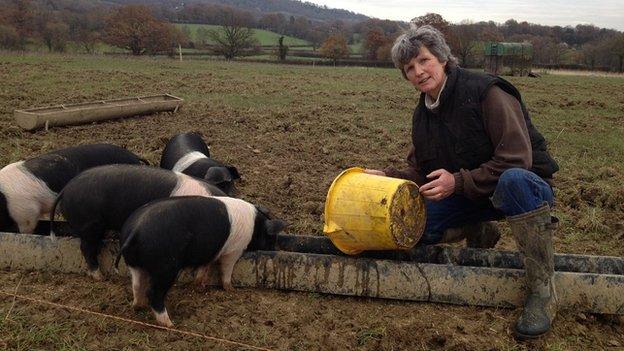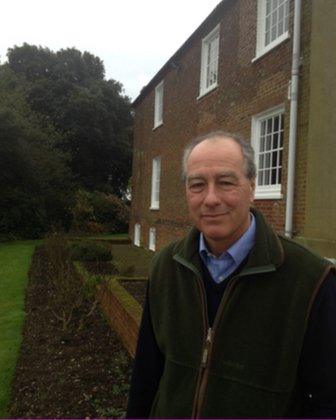Scramble for cash as farm subsidies pot shrinks
- Published

Fidelity Weston receives money for farming in a way that benefits bird life
The battle over the face of the countryside is entering its final phase in England and Wales.
The Environment Secretary Owen Paterson will announce in the next few weeks how he will divide subsidies to farmland.
The decision will impact the look of the landscape, the strength of rural economies, the health of wildlife and the profitability of farmers.
Mr Paterson is under pressure from all sides and his final decision will almost inevitably prove controversial.
The average household in Europe pays about £400 a year to subsidise farmers. In the summer, the EU set the framework for how the money should be spent with its scheme to "green" the Common Agricultural Policy (CAP).
The greening plans were heavily diluted under pressure from farmers, but large landowners will in future need to do more to collect subsidies by leaving existing grassland unploughed, diversifying their crops and setting aside some land for wildlife.
What’s being decided at the moment is exactly how the farm subsidy pot for in England and Wales should be divided between conflicting interests. The decision is tough because the overall size of the pot has shrunk as Europe’s leaders attempted to shrink the £50bn CAP.
Devolved system
In Scotland the government has decided to shift 9.5% of subsidies away from direct payments to farmers - a payment which is mostly for owning farmland. The money will go towards protecting wildlife and stimulating the rural economy.
In England and Wales ministers have indicated a wish to shift the maximum allowable – 15% - away from direct payments.

Mr Attwood says the subsidies are needed for England's farmers to compete in a global market
The National Farmers Union (NFU) in England says it will lose out to foreign competitors if the government transfers anything more, external than 9% away from direct farm payments.
The wildlife lobby criticises governments for failing to protect wildlife in the farm landscape and demands that its share of the decreasing pot should increase.
Meanwhile firms which are trying to make rural businesses more competitive are hoping that Mr Paterson will smile in their direction.
But farmers themselves are also divided between those who will benefit from the 15% transfer of funds into farm wildlife schemes and those who will lose out.
Kevin Attwood, for instance, is the sort of efficient food producer the NFU is keen to protect. With partners he farms 4,500 acres on the North Kent Downs near Sittingbourne. He collects around £450,000 in annual subsidies (the European Commission moved to cap subsidies to big farmers but this was resisted by the UK).
Broad view
Mr Attwood says the subsidies are needed for England’s farmers to compete in a global market.
He told me: “If you look at the rest of the world, much of it has GM technology for control of weeds, pests and diseases – none of that is available to us at the moment. In terms of subsidies elsewhere if you look at the States there are various schemes that support their farmers in different ways.
“In Europe, the basis of farm support has been there since the first six countries formed the (European Economic Community, or EEC, the forerunner of the EU) - so it’s reasonable that we should be treated the same as our competitors in Europe. If (the subsidies) go outside of agriculture completely it’ll be no good for farming in this country.”
Over on the west side of Kent, Fidelity Weston, an organic farmer near Sevenoaks, has a very different view.
She gets £24,000 a year from taxpayers – half as a direct payment, but half for farming in a way that benefits the skylarks that soar above her fields and the insect pollinators that lurk in the deliberately unkempt field corners.
She told me: “The CAP costs each householder £400 a year and if was living in a town I would want to be getting something for that - and what I would be getting is more wildlife in my garden thanks to a vibrant countryside."
She points to a recent report charting the precipitous decline, external of farmland birds.
“We’ve all seen a disappearance of the song thrush and so many other birds, so we should be putting more money not less towards wildlife enhancements. I don’t believe that farmers should get any money at all unless they can show that the public benefits from the subsidy by protecting wildlife and the countryside,” she said.
Wildlife groups say that even if the government shifts the maximum 15% away from direct payments it will still be insufficient to meet its own stated wildlife commitments.
It’s possible that both sides will be disappointed. Ministers aspire to bring fast broadband to the last 10% of the population but it is expensive and some providers want a 90% government subsidy.
The government also wants to improve grants which will help farm competitiveness, external. Funding for these projects could come out of the 15% transfer from direct farm payments.
The decision has to be announced by the end of the month.
Follow Roger on Twitter, external
- Published1 July 2013